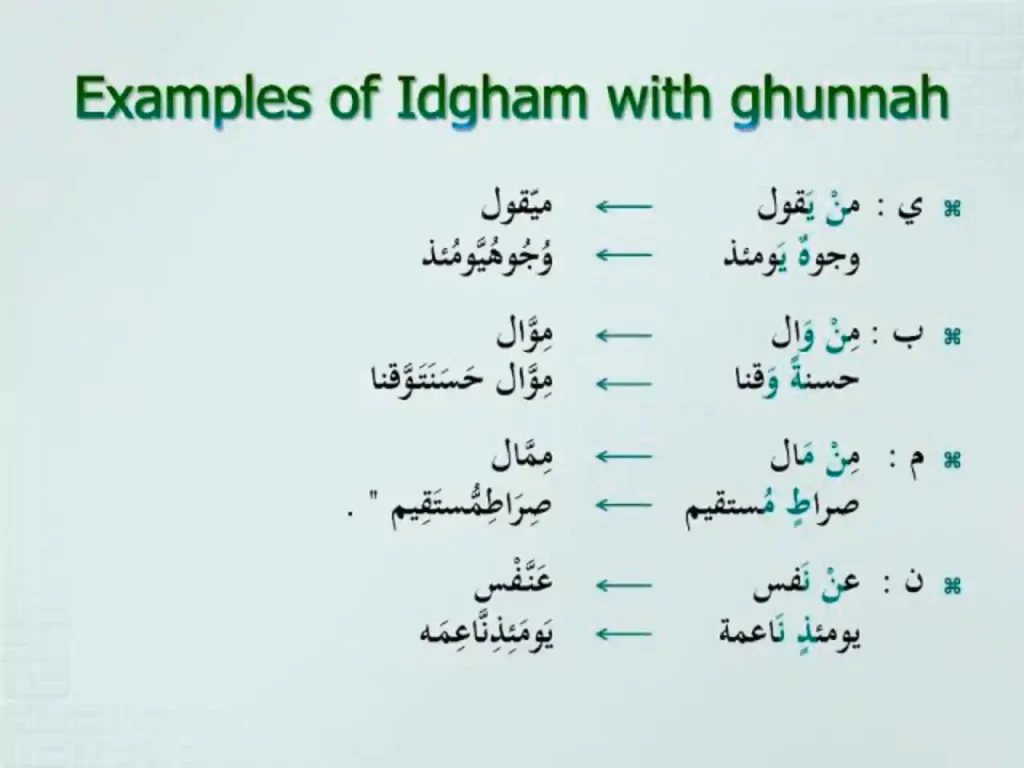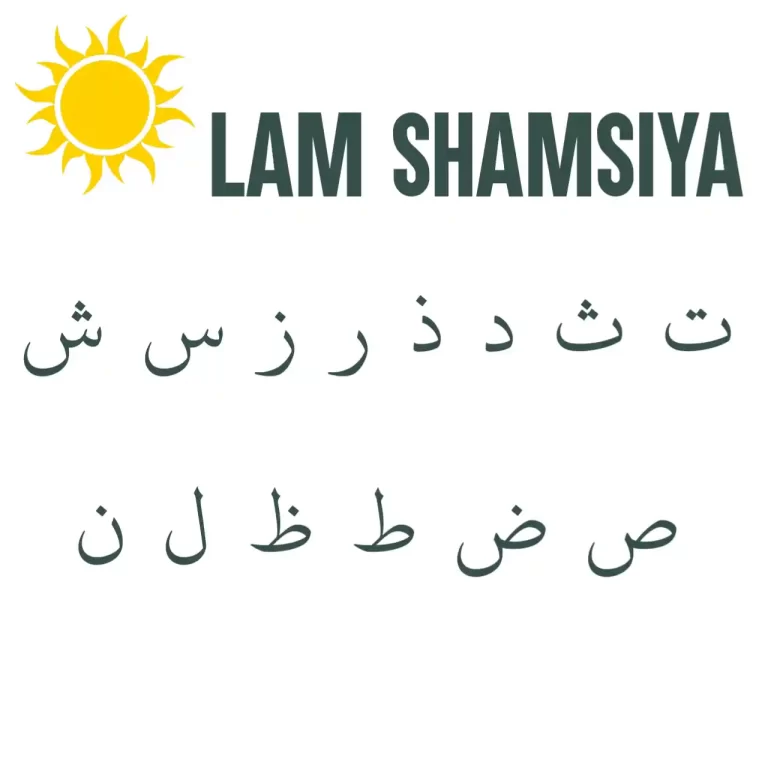Idgham Letters, Types, Rules, And Examples From Quran
Advertisements
In Tajweed, there are four rules on what happens when a letter accompanied by Noon Sakinah (نْ) or Tanween is followed by another letter. In both of the rules, Idgham occurs.
In this lesson, we will learn the meaning of idgham, idgham letters, rules, types, and examples from the Quran.
What Is Idgham In Tajweed?
Idgham is written in Arabic الإِدْغَام literally means to merge something into something else. And Idgham in terminology is confluence of a consonant letter with a vowel one, so these two letters become one letter, and pronounced as one letter with a weight of two letters.
Idgham Letters
There are 6 idgham letters in Tajweed. The letters causing idghaam of noon sakinah and tanween are as follows:
- الرّاء (ر)
- الميم (م)
- اللام (ل)
- الواو (و)
- النون (ن)
- الياء (ي)
These letters of idgham are collected in the word:
Advertisements
يَرْمَلُون
Note: Idghaam will only appear in two words.
If one of these six idgham letters appears at the start of a word that immediately follows one that ends in noon saakin or tanween, the noon merges into the following letter, this is idghaam.
Read 6 Izhar Letters in Arabic And Examples From Quran
Idgham Rules
The rules of idgham is if after Nun As-Sakinah or Tanween comes any of the Idghaam letters, you will merge the nun Sakinah or Tanween into the letter. The emphasis will be on the succeeding letter because of the presence of Shaddah.
Advertisements
In the way of idgham pronounciation, the ن sakinah and tanwin is absorbed or eaten up by the letter following it. Whenever the ن sakinah and tanwin are preceded by the idgham letters, it is pronounced with ادغام MERGE.

Types Of Idgham
ldgham is divided into two types. They are divided depending on the letter following it,the ن sakinah and tanwin is joined together and pronounced with nasalization called ادغام (EATEN UP) with ghunnah, or completely absorbed and eaten up by the letter after called ادغام (EATEN UP) without ghunnah.
The two types of idgham are as follows:
- ldgham with Ghunnah (Idgham Bighunnah)
- ldgham without Ghunnah

What Is Idgham Ghunnah?
Idgham Ghunnah also called idgham bighunnah is Idgham with nasalization (Ghunnah), a sound that comes out from the nose.
This type applies with certain letters of the Idgham letters, which include (ي, ن, م, و) or يَنْمُو. They are called letters of Idgham with Ghunnah.
If any letter appears after Noon Sakinah or Tanween, the Noon Sakinah or Tanween sound will be dropped, and the letter before the Noon Sakinah or the letter having Tanween will merge with the Idgham letter.
Whenever the ن sakinah or tanwin is followed by any of these four letters, it is eaten up by the following letter and pronounced with ghunnah.

What Is Ghunnah?
Ghunnah (nasalization) is the sound that comes from the nasal. It is the sound emitted through the nose, specifically when pronouncing the letters Noon نون and Meem ميم.
Idgham Bighunnah Examples
When the ن sakinah or tanwin is followed by ي yaa (or و wow) it is partially eaten up. The ن sakinah or tanwin is gone, however the attribute of ghunnah remains, and it is pronounced with nasalization. Like in:
- مَن يَقُولُ
- وُجُوهٌ يَوْمَئِذ
The ن sakinah is eaten up by the ي that comes after. However the ghunnah (nasalization) remains and it is not pronounced exactly like:
- مَ يَّقُولُ
- وُجُوهُ يَّوْمَئِذٍ
It should be pronounced with ghunnah (nasalization) and extended.
وَمَن يَعۡمَلۡ مِثۡقَالَ ذَرَّةٍ۬ شَرًّ۬ا يَرَهُۥ
Keep in mind that this rule occurs after the ن sakinah and tanwin, not after the م (meem):
وَلَمۡ يَكُن لَّهُ ۥ ڪُفُوًا أَحَدٌ
There is no idgham of the م (meem) in “لَمۡ” to the ي in “يَكُن”
When the ن sakinah or tanwin is followed by و wow (or ي yaa) it is partially eaten up. The ن sakinah or tanwin is gone, however the attribute of ghunnah remains, and it is pronounced with nasalization. Like in:
- مِنْ وَلِيٍّ
- نَعِيمًا وَمُلْكًا
The ن sakinah is eaten up by the و wow that comes after. However the ghunnah (nasalization) remains and it is not pronounced exactly like:
- مِ وَّلِيٍّ
- نَعِيمَا وَّمُلْكًا
It should be pronounced with ghunnah (nasalization) and extended.
تَبَّتۡ يَدَآ أَبِى لَهَبٍ۬ وَتَبَّ
When the ن sakinah and tanwin is followed by a م (meem), it gets eaten up by the م (meem) and is pronounced with ghunnah. The “n” sound changes to a “m” sound, and pronounced for a longer duration. Like in:
- مِن مَّاءٍ
- سُرُرٌ مَّرْفُوعَةٌ
Keep in mind whenever there is a م (meem) with shaddah مّ , or ن (noon) with shaddah نّ, it is pronounced with ghunnah. The nasalization sound is extended.
In this case with the م (meem) following the ن sakinah or tanwin, the م (meem) will always have shaddah, and the ن sakinah or tanwin is eaten up.
When the ن sakinah and tanwin is followed by a ن (noon), it gets eaten up by the ن (noon) and is pronounced with ghunnah. The “n” sound is pronounced for a longer duration. Like in:
- مِّن نِّعْمَةٍ
- يَوْمَئِذٍ نَاعِمَةٌ
Keep in mind whenever there is a ن (noon) with shaddah نّ , or م (meem) with shaddah مّ , it is pronounced with ghunnah. Also whenever a ن (noon) follows tanwin.
The nasalization sound is extended. In this case with the ن (noon) following the ن sakinah or tanwin, the “n” sound would be extended.
Whenever you find a ن (noon) with shaddah نّ it is like having two ن (noon)s . The first ن with a sakinah, and the second with a vowel (haraqah). The “n” sound would be pronounced with ghunnah and extended.
The “n” sound (ghunnah) is extended. It is good to recite along with a shaikh, to practice the extension.
What Is Idghaam Without Ghunna?
Idgham without ghunnah has two letters ل , ر. If any of these two letters come after Nûn As-Sakinah or Tanween it will be read without Ghunna.
When the ن sakinah and tanwin is preceded by either a ل lam or ر raa , it is completely absorbed by the following letter.
No sound of the ن or tanwin remains. Instead the letter connects to the ل lam or ر raa that comes after. It is like erasing the ن or tanwin, and connecting to the ل lam or ر raa after. The ن sakinah or tanwin disappears, and the ل lam or ر raa following it takes on a sakoon.

Listen to the following ayat:
{أَن رَّءَاهُ ٱسۡتَغۡنَىٰٓ}
Did you notice the pronounciation of the ن in “أَن” ? It got eaten up by the “ر” that is after. This occurs anytime there is a ر raa after a ن sakinah or tanwin.
Listen to the following ayat:
وَلَمۡ يَكُن لَّهُ ۥڪُفُوًا أَحَدٌ
Did you notice the pronounciation of the ن in “يَكُن” ? It got eaten up by the “ل” that is after. This occurs anytime there is a ل lam after a ن sakinah or tanwin.
Listen to the following ayat:
وَلَلۡأَخِرَةُ خَيۡرٌ۬ لَّكَ مِنَ ٱلۡأُولَىٰ
Can you point out where there is itgham in this ayat? The tanwin got eaten up by the “ل” that is after. This occurs anytime there is a ل lam after a ن sakinah or tanwin. The ر raa in خَيۡرٌ۬ loses the tanween and connects directly to the ل lam that comes after.
Idgham Examples From Quran
The two tables below have some examples of idgham from the Quran. For better understanding, we divided the table to idgham tanween examples and idgham Noon Saakin examples.
Idgham Tanween Examples
| Idgham Letters | Examples | How To Pronounce |
| الياء ي | لقومٍ يُؤْمنون | قومِ يُّؤمنون |
| النون ن | يومئذٍ نَاعمة | يومئذِ نَّاعمة |
| الميم م | جزاءً مِن | جزاءَ مِّن |
| الواو و | وليٌ وَلا | وليُ وَّلا |
| Without Ghunnah | ||
| الرّاء ر | غفورٌ رحيم | غفورُ رَّحيم |
| اللام ل | هدىً للمتقين | هدَى لِّلمتقين |

Idgham Noon Saakin examples
| Letters of idgham | Examples | How To Pronounce |
| الياء ي | فَمَن يَعمل | ميَّعمل |
| النون ن | من نِعمة | منِّعمة |
| الميم م | مِنْ مُكرِم | ممُّكرم |
| الواو و | مِن وَالٍ | مِوَّال |
| Without Ghunnah | ||
| الرّاء ر | من رَّبِّهِ | مرَّبِّه |
| اللام ل | مِّن لَّدُنْهُ | ملَّدُنه |

Advertisements







